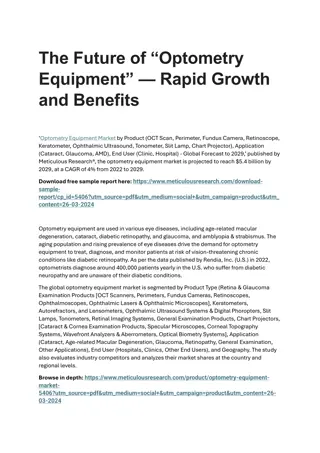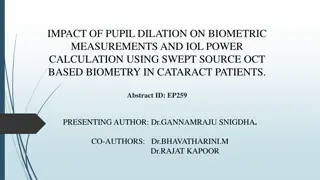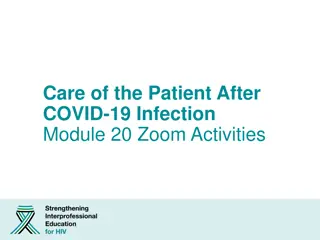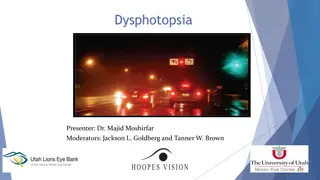Cataract post-op Care
Comprehensive post-operative care guidelines for cataract surgery patients, including monitoring for complications, addressing symptoms like headache and microcystic edema, and managing glaucoma. Learn how to assess wound integrity, IOL position, and corneal health post-surgery. Special considerations and steps for severe glaucoma and complicated surgeries are outlined as well.
Download Presentation

Please find below an Image/Link to download the presentation.
The content on the website is provided AS IS for your information and personal use only. It may not be sold, licensed, or shared on other websites without obtaining consent from the author.If you encounter any issues during the download, it is possible that the publisher has removed the file from their server.
You are allowed to download the files provided on this website for personal or commercial use, subject to the condition that they are used lawfully. All files are the property of their respective owners.
The content on the website is provided AS IS for your information and personal use only. It may not be sold, licensed, or shared on other websites without obtaining consent from the author.
E N D
Presentation Transcript
Cataract post-op Care Brian Wright, MD Mann Eye Institute
POD1 uncomplicated surgery Check Va Check IOP See following flow chart SLE Assess for cell / flare If hypopyon or > 3+ cell contact surgeon Assess wound for any leakage If seidel + contact surgeon Assess IOL position If any signs of malposition contact surgeon Assess cornea for excess swelling or microcystic edema Could be indicative of TASS or high IOP If patient has marked swelling only, consider adding 5% NaCl drop or ointment If there is blood in the AC, see if patient had MIGS procedure as this is likely cause If any nuclear fragments in the AC send the patient for next available appointment with the surgeon so it can be determined if surgery is required to remove
Symptoms Headache Microcystic edema Nausea / vomiting No Glaucoma, mild/mod Glaucoma <30 30 40 & no symptoms >40 or 30-40 w/symptoms normal care 1. Verify IOP 1. Verify IOP 2. Burp para to teens 2. Place gtts and verify IOP<30 before leaving office 3. Place on gtts until next visit 4. Contact surgeon if unable to lower IOP or possible diamox 3. Keep on gtt until next visit
Severe Glaucoma >30 25-30 1. Burp para to get IOP to teens <25 1.add gtt until next visit 2. Place on addition IOP gtt no care 3. Make F/U appt for the next day 2. Consider next day IOP check 4. Contact cataract surgeon
Additional concerns with complicated surgery Same concerns as previously stated Irregular peaked pupil Concern for iris to the wound If there is iris tissue outside the wound this is essentially an open globe and needs immediate notification to the surgeon Peaked pupil can be due to vitreous to the wound If vitreous is outside the wound this is an emergent referral back to the surgeon as the patient is at high risk for endopthalmitis If vitreous is inside the wound only and not on the surface then contact the surgeon to see patient next available for possible intraocular sweep or YAG vitreolysis Shallow AC , corneal striae with flouroscene Likelihood of wound leak (low IOP) so double check seidel Flat AC Possible wound gape or malignant glaucoma, urgent referral to surgeon
Endophthalmitis Rare complication following cataract surgery occurs in approximately 0.02-0.50 percent of cataract patients as a result of direct microbial invasion of the anterior chamber at the time of surgery or shortly after if patient has a wound leak In those microorganisms which are extremely virulent, clinical signs and symptoms generally occur within 72 hours. The patient presents with severe pain, loss of vision, lid and corneal edema, and conjunctival injection. A severe anterior chamber reaction may occur, possibly with hypopyon formation, and the pupillary area may be bridged by a fibrinous membrane as well as cells and protein in the vitreous Although the onset of endophthalmitis generally occurs within the first week following surgery, it may occur as early as 1 day or as late as many months after surgery If any suspicion of endophthalmitis immediate referral back to surgeon or retina colleague
POW1 Check Va Check IOP If new increase likely steroid response SLE Assess for cell / flare Should be decreasing from POD1 If unchanged or increased consider upping steroid frequency Endophthalmitis typically happens a few days after surgery so be wary of increased pain, decreased vision, or increasing inflammation Assess IOL position If any signs of malposition contact surgeon Check MRx If large refractive miss inform surgeon for possible adjustment on second eye
POM1 Check Va Check IOP SLE Assess for cell / flare Should be resolved If still present then possible rebound and restart taper Assess IOL position If any signs of malposition contact surgeon Check MRx If expectation is for better vision by patient due to AMP or ERP then have patient seen by surgeon without promising any possible procedure as surgeon will determine next step If standard case then Rx glasses If BCVa has 20/20 potential but patient cannot achieve despite MRx, then consider OCT macula to look for CME & assess surface for dryness/ irregularities as common cause of decreased BCVa
Various other concerns Various studies have shown approximately a 1.0 percent risk for retinal detachment following planned extracapsular or phacoemulsification cataract surgery. The incidence increases with intraoperative capsular bag rupture or vitreous prolapse and loss. Any iatrogenic retinal detachment usually occurs within 6 months of surgery. Ptosis is commonly observed within a few weeks of surgery. In the early postoperative period (1-14 days), the patient should be reassured that most cases of early postoperative ptosis resolve in days to months. Occasionally, the ptosis does not improve and surgical correction may be needed. Choroidal detachment is more common in high hyperopes or low IOP from prolonged surgery or wound leak. It can present with decreased visual acuity or mild discomfort, and the IOP is usually below 8 mm Hg. The characteristic clinical signs are smooth elevations of the peripheral choroid and retina.
UGH syndrome (uveitis-glaucoma-hyphem) Ocular hypertension or glaucoma induced by irritation from the IOL if the optic or haptic of an IOL is in contact with vascularized tissue This occurs more commonly with iris-fixated and anterior chamber IOLs; however, it can also occur with posterior chamber IOLs that are fixated in the ciliary sulcus, especially a one-piece IOL in the sulcus In this condition, hyphema and anterior chamber inflammation result in IOP elevation from obstruction of the trabecular meshwork with inflammatory and hemorrhagic debris. The iris should be carefully inspected for signs of transillumination defects. Send to surgeon as IOL may need to repositioned or exchanged
Questions? When in doubt contact the surgeon and ask























